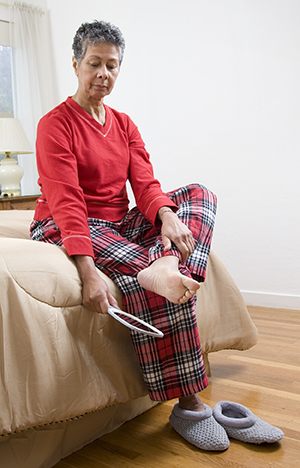Monitoring Moles
Moles are small, colored (pigmented) marks on the skin. They have no known purpose. Many moles appear before age 30. But they also often increase as people age. Moles most often aren't cancer (benign) and are harmless. But some moles become cancer (malignant). That’s why you need to watch the moles on your body. And tell your healthcare provider about any that concern you.
What are moles?
Moles are a type of pigmented mark. Freckles are another type of pigmented mark. They're often sprinkled across the bridge of the nose, the cheeks, and the arms. Moles can appear on any part of the body. There are many types, sizes, and shapes of moles. Most moles are solid brown. In most cases they are flat or dome-shaped, smooth, and have well-defined edges.
Why worry about moles?
Most moles are benign and don’t need treatment. You can have moles removed if you don’t like the way they look or feel. But moles may become a problem if they appear after you are 30. Or if they change in certain ways. These moles may turn into melanoma, a type of skin cancer. Melanoma rates have increased quickly over recent decades. It's often curable if caught early. But this disease can be life-threatening, particularly when not diagnosed early. Your risk for melanoma is higher if you:
-
Have a lot of moles
-
Have had more lifetime exposure to the sun or skin that burns easily
-
Have had severe blistering sunburns
-
Use tanning beds and sunlamps
-
Have a personal or family history of skin cancer
To manage your risk, it’s smart to check your moles for changes. Also ask your provider to do a complete skin exam when you have a physical exam. To do this, you first need to learn where your moles are. Then check your moles each month.
Checking your moles
You can check many of your moles each month. You can do this right after you shower and before you get dressed. Check your body from head to toe. Be sure to check hard-to-see places. These include your back, neck, buttocks, between your toes, and the bottom of your feet. You can check these areas by using mirrors or by asking someone you trust to help. Then make a list of your moles. If you find any new moles or changes in your moles, call your provider. To check your moles, you may need:
If you have a lot of moles, take digital photos of them. Make sure to take photos both up close and from a distance. These can help you see if any moles change over time.
 |
| Don't forget to check your feet. |
When to get medical care
See your healthcare provider if your moles hurt, itch, ooze, bleed, thicken, become crusty, or show other changes. Also call your healthcare provider if your moles show any of these signs of melanoma:
-
A change in size, shape, color, or height
-
The sides don’t match (asymmetry)
-
Ragged, notched, or blurred borders
-
Different colors in the same mole
-
Size is larger than 5 mm or 6 mm in diameter (the size of a pencil eraser)
-
Looks different from the other moles around it
-
It starts to itch
-
It is bleeds or oozes